We may not have the course you’re looking for. If you enquire or give us a call on 01344203999 and speak to our training experts, we may still be able to help with your training requirements.
Training Outcomes Within Your Budget!
We ensure quality, budget-alignment, and timely delivery by our expert instructors.

With industries turning more Agile, the demand for Agile Business Analysts has increased tremendously, and so has the competition among job seekers. So, if you want to ace the interview and step a little closer to landing your dream job, preparing with Agile Business Analyst Interview Questions is always a win-win.
Statista reports that, by 2026, global digital transformation spending will reach £3 trillion. Therefore, it is the right time to invest in Agile jobs and stand out in the highly competitive market.
Not sure where to start your preparation? Worry no more. In this blog, you will learn about the frequently asked Agile Business Analyst Interview Questions that will prepare you for your dream job.
Table of Contents
1) Agile BA Interview Questions – Beginner
2) Agile BA Interview Questions – Advanced
3) Agile BA Interview Questions – Scenario-based
4) Agile Business Analyst Interview Questions and Answers – General
5) Conclusion
Agile BA Interview Questions – Beginner
Have you just completed your degree and looking to crack an interview? If yes, then these Agile BA Interview Questions will benefit your preparation. Following are some basic Agile BA Interview Questions that can be useful for the freshers:
1) What do you mean by Scope Creep?
Scope Creep refers to the uncontrollable changes or shifts in the project scope within the same resource range. It indicates potential risk to a project or poor project management in some cases. Some possible causes of Scope Creep could be:
1) Lack of proper documentation regarding the project’s requirements
2) Poor communication among the Stakeholders of the project
2) Explain UML Modeling.
Unified Modeling Language (UML) is a visualisation approach used by Agile Business Analysts for visualising, documenting and developing the different elements of a system. This approach is primarily used for Software Development and for defining and outlining organisational functions, job roles and business processes.
3) What tools are helpful for Business Analysis?
The most commonly used tools for Business Analysis are:
a) Microsoft Office Suite
b) Python and R
c) SWOT analysis
d) Rational tools
e) Google docs
f) ERP systems
Note: It is recommended to tailor your answer to emphasise your skills and background in using these tools.
4) List some advantages of using Story Points in Agile project estimation.
During project estimation, using Story Points in Agile can prove beneficial in the following ways:
1) Using Story Points means the teams must compulsorily use velocity as their performance data for release planning
2) They eliminate the need for frequent re-estimation and work like a size-based estimate
3) The velocity Story Points make planning real and performance-based
4) Since there is no fixed timeline for work, therefore the team can perform rationally
5) Story Points instils collaboration in team’s behaviour
6) The involvement of different teams during estimation encourages a cross-functional behaviour
5) What are some diagrams that Agile BAs utilise in Business Analysis?
Among the most commonly used diagram models by business analysts are:
1) Flowcharts: They are a detailed graphical representation of the complete flow of the system that provides an understanding of the operations to all Stakeholders.
2) Use-case diagrams: The use-case diagrams devise the functionality of a system using a fixed set of functions, actions and services that the project needs to perform.
3) Activity diagrams: These diagrams illustrate a diverse set of activities and their flow across various departments.
4) Collaboration diagrams: These are also known as interaction or communication diagrams, primarily used to illustrate the interactions and connections among software objects in the Unified Modeling Language (UML).
6) What do you understand by BPMN, and what are its essential elements?
Business Process Model and Notation (BPMN) is a visual representation of all business processes. It essentially has five elements that are as follows:
1) Data
2) Flow Objects
3) Artefacts
4) Connecting Objects
5) Swimlanes
7) List some Agile Business Analysis techniques.
Following are some techniques used by Agile Business Analysts:
1) Strength – Weakness – Opportunities – Threats Analysis (SWOT)
2) Mission – Objective – Strategy – Tactics Analysis (MOST)
3) Specific – Measurable – Achievable – Realistic – Timely Analysis (SMART)
4) Business Process Modeling (BPM)
5) Use Case Modeling
6) Political – Economic – Social – Technological – Legal – Environmental Analysis (PESTLE)
8) List some popular Agile estimation tools and techniques.
Following are some of the popular Agile estimation tools and techniques:
1) Story points
2) Poker estimation
3) Delphi
4) Elative sizing
Learn about the role of Stakeholders in an Agile Project with our Agile Business Analyst Foundation And Practitioner (AgileBA®) course.
Agile BA Interview Questions – Advanced
Are you a working professional with six-nine years of experience? Or are you willing to change your career path for better opportunities in Agile Project Management? Then, these Agile BA Interview Questions are for you. Let’s look at some of the questions in detail:
9) Briefly explain the Gap Analysis.
Gap Analysis is a technique used to analyse the gap between the current business operations and functions and the desired operations. The Gap in Gap Analysis refers to the additional processes required to achieve the expected results. Performing Gap Analysis can help find out four different types of gaps, such as:
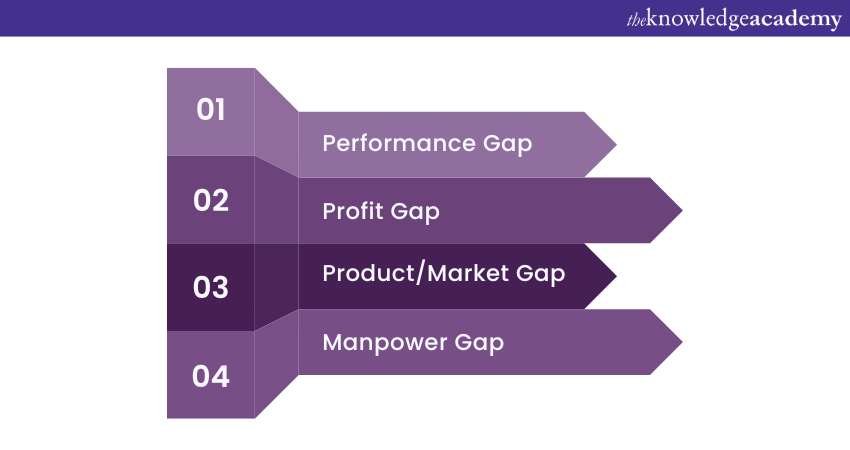
10) What can be some practices to follow while writing a use case?
The following are some practices that can be followed to write a use case:
1) Listing both functional and non-functional requirements in a use case
2) Having more than one flow along with the main flow as an alternative
3) A use case must describe what the system does and not the design
4) It must revert some value to the Stakeholder
11) How can you explain Business Analysis Process flow?
The Business Analysis Process is divided into multiple steps with specific tasks to perform, principles to follow and documents to create Let's have a look at an agile business analyst resume. Following are the steps involved in the process:
1) Collecting background information: It involves performing PESTLE Analysis and implementing Porter’s Five Forces framework.
2) Identifying the key stakeholders: This stage involves analysing Stakeholder’s Matrix.
3) Exploring business goal: Creating a Business Objectives List with focus groups and brainstorming using benchmarking techniques and SWOT Analysis.
4) Analyse the options available: Exploring the objectives listed in the previous stage through Cost-Benefit Analysis, Impact Analysis, Risk Analysis etc.
5) Describing the scope of the project: Developing a Scope Definition Document.
6) Outlining the delivery plan: After defining the scope, the next stage involves describing the delivery plan.
7) Defining project requirements: It focuses on describing functional & non-functional requirements by conducting Stakeholder interviews and using requirements-defining techniques.
8) Implementing the plan: It involves using Software Development Life Cycle (SDLC) method in Agile.
9) Analysing the value added by the project: This stage involves testing the actual progress of the project across the timeline and whether it has met the business objectives.
12) How to handle changes to requirements?
Interviewers usually ask this question to test your logical thinking skills and how well you handle situations like this. Therefore, it is vital to remember that your answer must highlight your skills as an Agile Business Analyst. You can frame your answer in the following manner:
To handle the changes in requirements, I would first do the feasibility study to check whether to proceed with the proposed requirements. Further, I would perform an Impact Analysis to identify the amount of resources, time and money required to be implemented to make changes in the project. This is followed by evaluating the scope of change and checking whether it leads to new gaps in the development and testing designs.
Understand the basics of Sprint and Product Backlog. Join our Agile Business Analyst Foundation (AgileBA®) course now!
13) How is Agile different from traditional Waterfall methods?
The traditional methodologies engage in Software Development in a linear format where each phase depends on the successful completion of the previous one. Whereas Agile methodology follows an iterative process for Software Development, providing constant feedback and rectifying customer inputs.
The Agile methodology is also much more focused on customer involvement at every stage of the project. Further, the Agile methodology is generally more flexible and responsive. In contrast, the Waterfall methods are planned way ahead of time and require the completion of one phase before beginning with the next one.
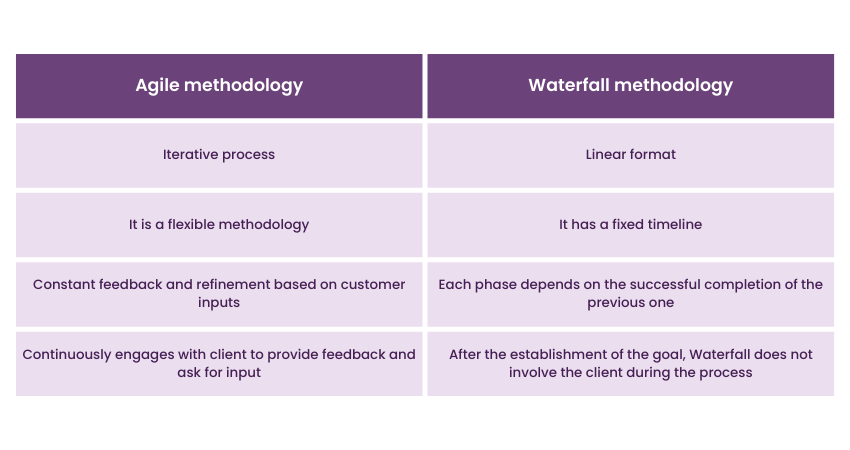
14) What steps will you take to avoid Scope Creep?
You can answer the question in the following manner:
To avoid Scope Creep, I would:
1) Ensure that the project’s scope does not deviate
2) Follow the proper change management process
3) Create a detailed document with new requirements
4) Communicate clearly with the Stakeholders about the new requirements
5) Ensure not to add extra features to the current functionalities
15) What does requirement elicitation mean?
Requirement elicitation is a process of gathering requirements from Stakeholders, end-users and customers. It uses different techniques to do so. Those techniques are:
1) Brainstorming and interviewing
2) Preparing samples
3) Observing
4) Document analysis
5) Surveying
6) Creating focus groups
7) Interface analysis and conducting requirement workshops
16) How should an Agile Business Analyst prioritise requirements?
There are many factors to consider when prioritising requirements. Firstly, understand the Stakeholder’s and customers’ requirements. It means analysing their goals and understanding specific needs. Secondly, keep the timeline, budget and resources allocated to the project in mind. Notably, in some scenarios, Business Analysts may also require to trade off one requirement for another.
Agile BA Interview Questions – Scenario-based
The Interviewers often ask scenario-based questions to test your capability of handling crises and critical thinking skills. Here’s a list of a few scenario-based questions that will prepare you to catch all kinds of questions that Interviewers will throw at you:
17) How are Product Backlogs helpful for Agile Business Analysts?
To answer this question, you must first explain the meaning of Product Backlog. Further, list the advantages of having a Product Backlog in Agile. You can say the following:
Product Backlogs can be extremely helpful for an Agile BA because of the following reasons:
1) Keep track of all the different parts of a project that need to be completed
2) Identify the priority tasks and ensure that all team members work towards the same goal
18) If a conflict arises within the project, how would you handle that?
This interview question is often asked to test how well you implement various competencies such as problem-solving, communication, and negotiation skills. You can answer this question in the following way:
If any conflict arises within the project, firstly, I will try to identify the source of the conflict. Once I get to the root cause, I will look for possible solutions. One possibility can be bringing the parties involved together to discuss their concerns. If it doesn’t work, I might mediate the conversation or offer a compromise. While doing the needful, I will try to keep the communication open and honest so that everybody can see the cause of conflict themselves and work on it.
Gain in-depth knowledge of various Business Analysis techniques with our Agile Business Analyst Practitioner (AgileBA®) course.
19) How would you maintain a positive relationship with your team members?
One of the most important things expected from an Agile Business Analyst is maintaining a positive relationship with their team to ensure everyone is on the same page. You can answer this in this way:
To maintain good relations with the other team members, I would do the following:
To maintain a good relationship with the other team members, I would do the following:
1) Facilitate clear communication between team members as they need to collaborate constantly, and tasks are continually changing.
2) Keep every team member updated on the latest developments, giving no place to misunderstandings and ensuring everyone is working towards the same requirements.
3) Continuously receive feedback from team members and consider their input when making decisions.
20) How can you influence multiple Stakeholders at the same time?
Being an Agile Business Analyst means collaborating with multiple people in different positions. While doing so, there may be times when your ideas might not match with that of the others. This is where your influencing, communication and collaboration skills are to test. Here are some tips for answering this question:
Use the Situation, Task, Action and Result (STAR) method:
1) Explain the given situation
2) Understand your tasks
3) Outline the actions you will take in this case
4) End your answer by explaining the result and its learning outcomes
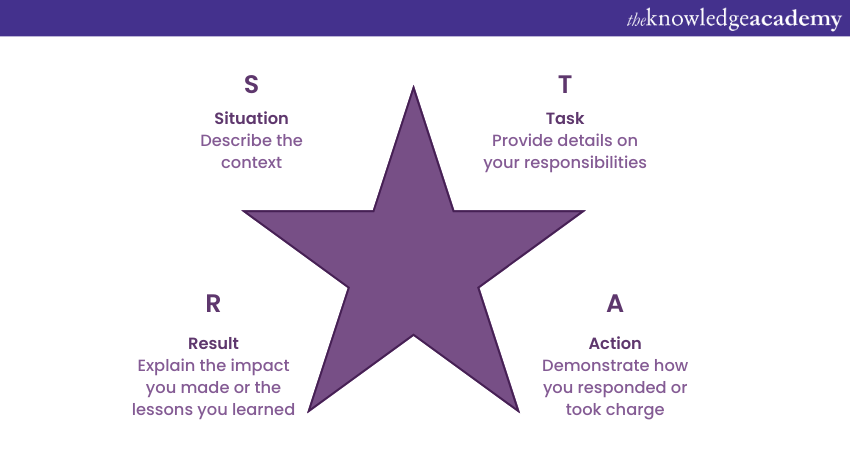
21) Describe some problems an Agile Business Analyst may face during the project lifecycle.
During a project lifecycle, an Agile Business Analyst might face the following problems:
1) Continuously changing business needs or requirements
2) Conflict with users, Stakeholders and team members
3) Technical and access-related problems
4) Unrealistic timelines
22) Why do you think Business Analysts are important in Agile Project Management?
Agile Project Management is not limited to Software Development. It has other business aspects to it as well that need to be continuously looked after. Therefore, an Agile BA becomes important because they:
1) Recognise business requirements
2) Analyse the business domain in detail
3) Stock and groom the Product Backlog
4) Assists the teams in understanding the requirements
23) Is Agile a good methodology for handling projects? What are your thoughts on that?
Hearing the words “your thoughts,” many candidates get nervous. However, the question is not as tricky as it might sound. This question mainly asks you to list the advantages and disadvantages of the Agile methodology. Therefore, you can first explain some benefits and drawbacks of Agile. Further, evaluate whether this methodology benefits you as an Agile BA. Also, remember to provide a reason for your answer.
Learn how to analyse and model business activities. Register for our BCS Certificate In Business Analysis Practice course now!
Agile Business Analyst Interview Questions and Answers – General
If you are preparing to ace the Agile Business Analyst interview, then you must know that there are certain questions that all Hiring Managers ask the candidates. These general interview questions are the true testification of your personality and interpersonal skills.
Therefore, it is important to be entirely prepared to answer them. Here are a few general interview questions and answers to help you seem more confident and impress the Interviewers:
24) Please introduce yourself.
This is one of the most important questions that test whether Agile BA knows what is expected from them. The candidates can answer the question in this manner:
1) The first step is to provide personal information such as your name, place of birth, interests and hobbies
2) Next, proceed with talking about your educational qualifications. It is important to talk about your most recent degree or qualification. Add academic achievements (if any)
3) Further, talk about your previous job role and particularly mention your achievements
4) You can also talk about your strengths and weaknesses
5) Lastly, be confident
25) Can you list some skills required to become an Agile Business Analyst?
This is one of the most important questions that tests whether Agile BA is aware of what is expected from them. The candidates can answer the question in this manner:
1) Begin by talking about your hard skills that are particular to the role. These skills include knowledge of Agile Processes and methodology, familiarity with requirement techniques, understanding of technical business areas related to the project, Agile Modeling, etc.
2) Further, you can discuss the soft skills an Agile Business Analyst requires. Remember, mention only those skills that seem to be acceptable for the business analyst role in agile rather than throwing words in the air
3) You can mention communication skills such as solution-providing capabilities, flexibility and adaptability to changes, analytical skills etc.
Note: You can further talk about the skills that you possess and how those skills are compatible with this job role
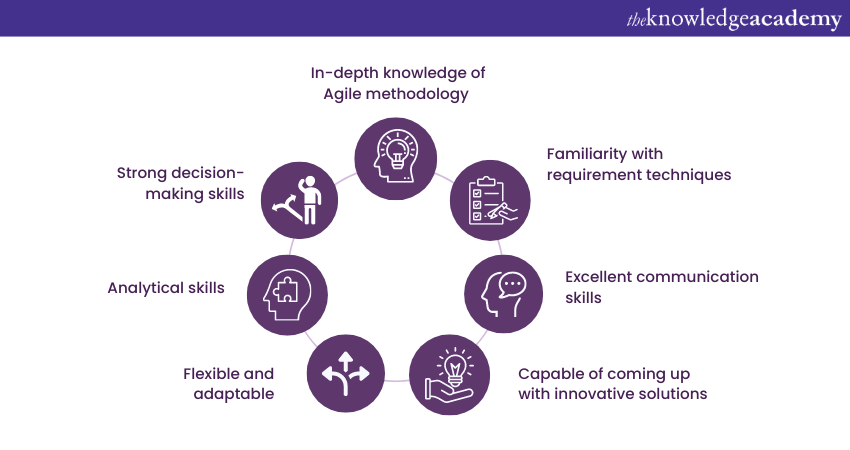
26) How do you see Digital Transformation in the near future?
Know-how of Digital Transformation is integral to the Agile Business Analyst role. Therefore, the candidates must be familiar with the current and upcoming tools and technologies that are assisting in keeping the business operations aligned. Here’s an outline of how you can answer this question:
1) Talk about the current situation of the technological market and how digital transformation is taking over the industries
2) Give examples or statistics to showcase that you have the appropriate knowledge of the digital trends
3) Lastly, talk about the future possibilities of digital transformation for businesses. It will require you to research a little on the topic
Sample answer: Today, almost all industries are in the race to transform themselves digitally. After surviving the blow of the pandemic, digitisation has become integral to their responses and their future. This means digital technologies will be influential in formulating enterprise strategies. This transformation is evident from World Economic Forum’s report, which states that Digital Transformation will add £80 Trillion to the world economy by 2025.
Businesses are rapidly moving towards using innovation platforms and low-code solutions to increase the market size, which can further add to their business value. Apart from that, Data Analysis is seemingly taking over the industries as Stakeholders expect to understand and analyse business risks from enterprise climate change.
Further, technologies such as Artificial Intelligence (AI), Machine Learning (ML) and multi-cloud solutions are promised to increase business conversion rates and create additional sales funnels, improving customer experience.
Gain an in-depth understanding of the role of a Business Analyst in Agile. Register for our Agile Business Analysis Training course now!
27) How does the role of a Business Analyst and Agile methodology relate to each other?
This question is often asked to the candidates transforming from traditional BA to Agile BA. The Hiring Managers particularly look at whether the person understands the seriousness of the role and is aware of the key responsibilities of an Agile Business Analyst. The candidates can answer this question in the following manner:
The Agile Manifesto describes four fundamental values and 12 principles. It is these principles that guide Business Analysts on how to reflect Agile values. They are particularly engaged in finding out the following:
1) Which processes are required to be added, removed or reworked?
2) Which Stakeholders are the ultimate decision-makers?
3) What data to derive from a running project to improve upon future projects?
28) What are the various Agile principles?
The 12 manifesto principles of Agile methodology are as follows:
1) Adjusting to the continuously changing requirements during the development process
2) Frequent delivering the developed software components
3) Maintaining communication between the Stakeholders and Developers throughout the project
4) Encouraging, helping and trusting the people involved in the project
5) Allowing one-on-one communications
6) Validating functioning software as the primary measure of progress
7) Performing iterative processes to ensure a uniform development pace
8) Directing attention towards technical design and details to enhance the agility
9) Comprehensibility
10) Ensuring customer satisfaction through early and regular product delivery
11) Ensuring that the teams are self-organised and motivated and encouraging great requirements, architectures, and designs
12) Focusing on how to become more effective and efficient
29) Briefly describe the four Agile Values.
The Agile Manifesto stands on four foundational Values that are as follows:
1) Individuals and interactions over processes and tools: It implies that people and their interactions are more valuable than the process and tools used during a project.
2) Working software over comprehensive documentation: This value emphasises reducing project documentation efforts. Instead, Agile believes in collaboration and interactions among teams.
3) Customer collaboration over contract negotiation: Agile emphasises engaging with customers throughout the project by providing continuous delivery and feedback, ensuring that the project requirements are met through collaboration.
4) Responding to changes over sticking to a plan: Agile development involves responding to changes as soon as requested. It is important for the improvement of the project.
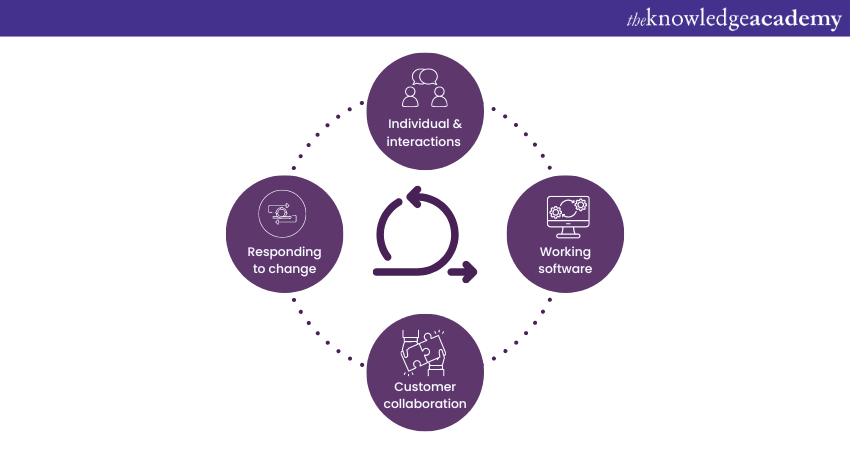
30) What do you think is the role of a Business Analyst in an Agile environment?
In an Agile environment, a Business Analyst in Agile Team must play not just one but many roles. These roles are as follows:
1) Product owner: Analysing features and requirements of the product.
2) Scrum Master: Facilitating the Scrum process and ensuring the development team understands the requirements clearly.
3) Business Advisor: Gathering and analysing data to guide Stakeholders in decision-making. They also work closely with the Product Owner and Scrum Master, ensuring that the product meets the customer’s requirements.
4) Communicator: Communicating with the Agile team as Analytics Specialists to encourage collaboration, provide examples, and transfer knowledge.
Conclusion
If you are preparing for an Agile Business Analyst job interview, then it can become overwhelming. There are multiple aspects to remember and pressure to face the Interviewer. However, we hope that Agile Business Analyst Interview Questions provided in the blog have taken a little pressure off you.
Learn about the purpose of Business Analysis in a Scrum environment with our Agile Business Analysis In A Scrum Environment course.
Frequently Asked Questions
Upcoming Business Analysis Resources Batches & Dates
Date
 Agile Business Analyst Foundation and Practitioner (AgileBA®)
Agile Business Analyst Foundation and Practitioner (AgileBA®)
Mon 20th May 2024
Mon 1st Jul 2024
Mon 19th Aug 2024
Mon 14th Oct 2024
Mon 11th Nov 2024
Mon 9th Dec 2024







 Top Rated Course
Top Rated Course



 If you wish to make any changes to your course, please
If you wish to make any changes to your course, please


